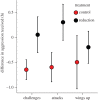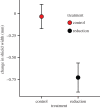Manipulating the appearance of a badge of status causes changes in true badge expression
- PMID: 24285201
- PMCID: PMC3866412
- DOI: 10.1098/rspb.2013.2680
Manipulating the appearance of a badge of status causes changes in true badge expression
Abstract
Signals of dominance and fighting ability (i.e. status signals) are found in a wide range of taxa and are used to settle disputes between competitive rivals. Most previous research has considered status-signal phenotype as an attribute of the individual; however, it is more likely that signal expression is an emergent property that also incorporates aspects of the social environment. Furthermore, because an individual's signal phenotype is likely to influence its social interactions, the relationships between status signals, social environment and individual quality are probably much more complex than previously appreciated. Here, we explore the dynamic relationship between social interactions and signal expression in a previously undescribed status signal, the frontal shield of the pukeko (Porphyrio porphyrio melanotus: Aves). We demonstrate that frontal shield size is a strong predictor of dominance status within social groups, even after controlling for potentially confounding variables. Then, we evaluate the relationship between social interactions and signal expression by testing whether manipulating apparent shield size influences (i) dominance interactions and (ii) future signal expression. By showing that decreasing apparent shield size causes both an increase in the amount of aggression received and a decrease in an individual's true shield size, we provide the first evidence of dynamic feedback between signal expression and social interactions. Our study provides important insight into the role of receiver-dependent (i.e. social) costs in maintaining signal honesty and demonstrates a unique approach to studying status signalling applicable to future studies on dynamic morphological signals.
Keywords: badges of status; dominance; handicap hypothesis; honest signalling; resource-holding potential.
Figures



References
-
- Searcy W, Nowicki S. 2005. The evolution of animal communication. Princeton, NJ: Princeton University Press
-
- Fitch WT. 1997. Vocal tract length and formant frequency dispersion correlate with body size in rhesus macaques. J. Acoust. Soc. Am. 102, 1213–1222 (doi:10.1121/1.419022) - DOI - PubMed
-
- Vannoni E, McElligott AG. 2008. Low frequency groans indicate larger and more dominant fallow deer (Dama dama) males. PLoS ONE 3, e3113 (doi:10.1371/journal.pone.0003113) - DOI - PMC - PubMed
-
- Zahavi A. 1975. Mate selection: a selection for a handicap. J. Theor. Biol. 53, 205–214 (doi:10.1016/0022-5193(75)90111-3) - DOI - PubMed
-
- Grafen A. 1990. Biological signals as handicaps. J. Theor. Biol. 144, 517–546 (doi:10.1016/S0022-5193(05)80088-8) - DOI - PubMed
Publication types
MeSH terms
LinkOut - more resources
Full Text Sources
Other Literature Sources

